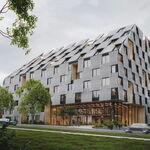NBGtect
Active Member
I really don't see the appeal of Graham Hill let alone have a collection of units marketed with his name. Has anyone seen him speak? He just seems so sad and miserable and not the slightest bit convincing or inspiring. There are far better and inspiring visionaries who live in humble dwellings and who practice frugality in their daily lives. All Graham needs to do is smile when he speaks and lighten up!
We do live in tough times and a lot of what we do is unsustainable. But this isn't new by any means. People have been living with little for a long time.
Read the old book,"Your Money or Your Life" for actual inspiration with people who practiced living in small spaces with financial independence as their primary goal. I just feel that Graham used his design competition and little apt makeover mostly as a massive marketing tool to promote his own projects (which he has many) rather than actually be happy about his life. But it seems to have caught on since Urban Capital can also profit and market tiny spaces as something desirable for the planet (rather than merely to line their own pockets).
If people are really interested in sustainability, there are many well-respected authors, speakers, and those who live this way that will inspire you. This, unfortunately, is merely a marketing ploy to profit others. The two best things that you can do to save money is 1.) Stop trying to impress others; 2.) Rent or invest in a freehold but don't waste money on a condo!
We do live in tough times and a lot of what we do is unsustainable. But this isn't new by any means. People have been living with little for a long time.
Read the old book,"Your Money or Your Life" for actual inspiration with people who practiced living in small spaces with financial independence as their primary goal. I just feel that Graham used his design competition and little apt makeover mostly as a massive marketing tool to promote his own projects (which he has many) rather than actually be happy about his life. But it seems to have caught on since Urban Capital can also profit and market tiny spaces as something desirable for the planet (rather than merely to line their own pockets).
If people are really interested in sustainability, there are many well-respected authors, speakers, and those who live this way that will inspire you. This, unfortunately, is merely a marketing ploy to profit others. The two best things that you can do to save money is 1.) Stop trying to impress others; 2.) Rent or invest in a freehold but don't waste money on a condo!




